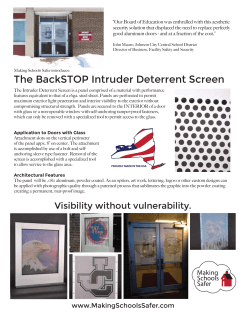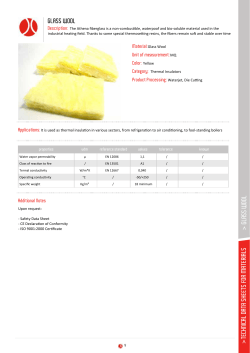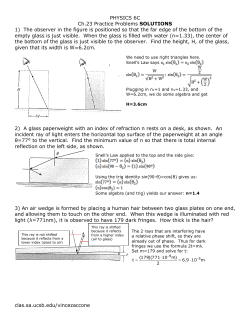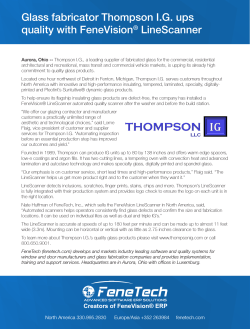
this PDF file - TÃBÄ°TAK ULAKBÄ°M DergiPark
ANADOLU ÜNİVERSİTESİ BİLİM VE TEKNOLOJİ DERGİSİ – Uygulamalı Bilimler ve Mühendislik A ANADOLU UNIVERSITY JOURNAL OF SCIENCE AND TECHNOLOGY – Applied Sciences and Engineering A Cilt/Vol.: 13-Sayı/No: 2 : 81-87 (2012) ARAŞTIRMA MAKALESİ / RESEARCH ARTICLE PRODUCTION OF Pr6O11-DOPED SrAl2O4:Eu2+, Dy3+, Y3+ YELLOWISH-GREEN PHOSPHORS AND THEIR USAGE IN ARTISTIC GLASSES Hanaa El KAZAZZ 1, Erkul KARACAOĞLU 2, Bekir KARASU 2, Mustafa AĞATEKİN 3 ABSTRACT A phenomenon of light emission by certain materials after exposure to an excitation source is called luminescence. Long persistent phosphors are those having very long afterglow emission or phosphorescence, in some cases even longer than a whole day, and a large application fields. Afterglow is caused by trapped electrons or holes produced during the excitation. The long persistent phosphorescence mechanism of the inorganic phosphors activated by rare earth ions have been attempted to be explained by many researchers. During the last decade, the researches on the development of new persistent phosphors and the improvement of their life time have been considerably conducted. In the present study, the effects of praseodymium oxide (Pr6O11) doping in SrAl2O4:Eu2+, Dy3+, Y3+phosphor on the luminescence efficiency and phosphorescence properties were investigated. Additionally, after the production, the possible application of the most suitable pigment developed during the study onto artistic glasses was searched. Keywords: Pr6O11, Doping, SrAl2O4:Eu2+, Dy3+, Y3+ phosphor, Usage, Effect, Artistic glasses. SrAl2O4:Eu+2, Dy+3, Y+3 SİSTEMİNDE Pr6O11 KATKILI SARIMSI-YEŞİL FOSFORLARIN ÜRETİMİ VE SANATSAL CAMLARDA KULLANIMI ÖZ Bir uyarım kaynağına maruz bırakılan bazı malzemelerin kaynak uzaklaştırıldıktan sonra da ışık yayınımına devam etmeleri olayına lüminesans adı verilmektedir. Uzun ışıldama süreli fosforlar, çok geniş bir zaman diliminde, hatta bazen bütün bir gün boyunca bu yayınımı yapabilen ve fosforesans özellik sergileyen, oldukça geniş uygulama alanına sahip malzemelerdir. Işıldamada kalıcılık, uyarım süresince tuzaklanan elektronlar veya meydana gelen boşluklar neticesinde ortaya çıkmaktadır. Nadir toprak iyonları tarafından aktive edilen inorganik fosforlarda uzun süre kalıcı fosforesans mekanizması birçok araştırmacı tarafından açıklanmaya çalışılmıştır. Son 10 yılda araştırmacılar yeni kalıcı fosforların geliştirilmesi ve sönümlenme ömürlerinin iyileştirilmesi üzerine başarılı çalışmalar gerçekleştirmişlerdir. Bu araştırmada, SrAl2O4:Eu+2, Dy+3, Y+3 sistemindeki fosfora prasedmiyum oksit (Pr6O11) katkılamasının lüminesans verimine ve fosforesans özelliklere etkileri araştırılmıştır. Ayrıca, optimum özelliklere sahip şekilde geliştirilen fosforesans pigmentlerin sanatsal camlarda uygulanması üzerine çalışmalar yapılmıştır. Anahtar Kelimeler: Pr6O11, Katkılama, SrAl2O4:Eu+2, Dy+3, Y+3 fosforu, Kullanım, Etki, Sanatsal camlar. 1, Helwan University, Faculty of Applied Arts, Glass Department, Cairo/Egypt. Anadolu University, Faculty of Engineering and Architecture, Department of Materials Science and Engineering, Eskişehir/Türkiye. E-mail: bkarasu@anadolu.edu.tr (Bekir Karasu) 3, Anadolu University, Faculty of Fine Art, Department of Glass, Eskişehir/Türkiye. 2, Recieved: 2 February 2012; Revised: 10 February 2012; Accepted: 13 February 2012 2 1. INTRODUCTION The scientific researches on phosphors have a long history going back to more than 100 years. From the late 19th to the early 20th century, Philip E. A. Lenard and co-workers in Germany performed active and extensive researches on phosphors, and achieved impressive results. They prepared various kinds of phosphors based on alkaline earth chalcogenides (sulphides and selenides) and zinc sulphide, and investigated the luminescence properties. Since the end of the World War II, researches on phosphors and solid-state luminescence have evolved dramatically. Searches on phosphors and their applications cover a numerous fields in science and technology. Synthesis and preparation of inorganic phosphors are based on physical and inorganic chemistry (Yen et al, 2007a). During the last decades, the long-lasting phosphors have attracted much attention because they have extensive practical and potential applications in many fields, e.g. emergent lighting, electronic displays, the detection of high-energy rays such as UV, X-ray, etc., and multi-dimensional optical memory and image storage (Wei et al., 2009). The green light emitting SrAl2O4, co-doped with Eu2+ and Dy3+ ions, having applications in large areas, such as luminous paints in highway, airport, buildings and ceramic products has been widely studied as a long afterglow phosphor. The excited 4f6 5d1 configuration of Eu2+ is extremely sensitive to the change in the lattice environment of host structure (Kaya, 2011, Kaya and Karasu, 2012, Kaya et al., 2012, Karacaoglu et al., 2011, Unal et al., 2011, El Kazazz et al., 2011, Kaya and Karasu, 2011, Kaya et al., 2010a, Kaya et al., 2010b, Kaya et al., 2010c, Karasu et al., 2010, Kaya et al., 2010d, Kaya et al., 2009). Most phosphors are composed of a transparent microcrystalline host (or a matrix) and an activator, i.e., a small amount of intentionally added impurity atoms distributed in the host crystal. Therefore, the luminescence processes of a phosphor can be divided into two parts: the processes mainly related to the host, and those that occur around and within the activator. The lanthanide ions, either in their divalent or trivalent charge states, form a very important class of luminescence activators in phosphors and single Anadolu Üniversitesi Bilim ve Teknoloji Dergisi - A 13 (2) Uygulamalı Bilimler ve Mühendislik crystals. The photon cascade emission involving the 4f2 levels of Pr3+ has been investigated for developing high quantum efficiency phosphors excited by means of a Xe discharge in the vacuum-UV (Yen et al., 2007b). Fig. 1 illustrates the importance of the lowest energy 5d level location relative to 4f2 levels in Pr3+. With the 5d level above the 1S0 level of Pr3+, multi-phonon relaxation from the lowest 5d state to the lower lying 1S0 level takes place. A cascade emission of two photons may result, which leads to quantum efficiency larger than 100 %. However, with the lowest 5d state below 1S0, broad-band 5d-4f emission is observed. Much researches are devoted toward the search for Pr3+ quantum-splitting phosphors and for finding efficient 5d-4f-emitting Pr3+doped materials for scintillator application (Yen et al., 2007b). Figure 1. The illustration showing the importance of the lowest energy 5d level location relative to 4f2 levels in Pr3+ (Yen et al, 2007b). Pr3+-doped fluoride and oxide crystals and glasses have been studied for a long time for their UV emission applications and their visible ones for multi-color lasers in high-definition TV, in medical applications, and their near infrared one for fiber-optic communications. Also, one of the hosts belonging to the strontium aluminate phosphor doped with Pr3+ rare earth ions, with magnetoplumbite-type structure has been reported as a quantum cutting phosphor exhibiting photon cascade emission (PCE) (Sharma et al., 2008). In this study, the photo luminescence properties of Pr3+ ions incorporated (at the levels Anadolu University Journal of Science and Technology - A 13 (2) Applied Sciences and Engineering 2. EXPERIMENTAL SrCO3, α-Al2O3, H3AlO3, Eu2O3, Dy2O3, Y2O3, Pr6O11 and H3BO3 with high purity were used as starting materials because the solid-state reaction route was chosen to prepare long afterglow phosphorescent pigments co-doped with Pr3+. The thoroughly weighed recipes including Pr6O11 and coded as A-E were milled in zirconium oxide bowls using zirconium oxide balls and isopropyl alcohol at 200 rpm for 1 hour in a planetary mill. The mixed solutions were dried in an oven at 90 ºC for 12 hours. The dried powder mixtures were then fired in alumina crucibles in a laboratory type tunnel furnace at about 1400-1550 ºC for 1-5 hours. The crystalline structure of the phosphors powders was analyzed by X-ray diffractometer (XRD at 40 kV and 30 mA with Rigaku Rint 2000 using Cu Kα radiation). The morphology and size of the powders were observed employing a scanning electron microscope (SEM-Zeiss EVO50). After sintering and sieving, the particle size distributions of phosphors were determined by using Malvern Instruments Mastersizer Hydro 2000G laser particle size analyzing instrument. Pr3+ (the best one in terms of luminescence) after sintering and grinding are given in Figs. 2-4. As seen in both systems, the major crystal phase is SrAl2O4 and secondary ones seem to be AlYO3, SrAl4O7 and SrB2O4. The excitation and emission spectra of SrAl2O4:Eu2+, Dy3+, Y3+ versus SrAl2O4:Eu2+, Dy3+, Y3+, Pr3+ phosphors are shown in Fig. 5. of 0.0001-0.0005 moles) in strontium aluminate (SrAl2O4: Eu, Dy, Y) was investigated. (a) (b) Figure 2. The particle size analysis results of the phosphorescence base sample in the SrAl2O4: Eu2+, Dy3+, Y3+ (a) and C one (with 0.0003 moles Pr6O11) in the SrAl2O4: Eu2+, Dy3+, Y3+, Pr3+ systems (b) after sintering and dry-grinding. The excitation and emission spectra were recorded on the powder samples using a fluorescence spectrophotometer (Perkin Elmer LS55). All the measurements were performed at room temperature. 3. RESULTS AND DISCUSSION After sintering the samples at certain temperatures for determined time, dry-ground phosphors were analyzed by laser particle size analysis and a scanning electron microscope (SEM) to investigate particle size distributions and element analysis, respectively. The particle size analysis results, XRD graphs, SEM images and EDX results of the phosphorescence base and C sample including Figure 3. The XRD results of the phosphorescence base and C one (with 0.0003 moles Pr6O11) samples after sintering. 4 Anadolu Üniversitesi Bilim ve Teknoloji Dergisi - A 13 (2) Uygulamalı Bilimler ve Mühendislik (a) (b) Figure 5. (a) The excitation and (b) emission analysis results of the base sample and the one co-doped (sample C) with 0.0003 moles Pr6O11. (b) (c) (d) Figure 4. (a-b) SEM photographs and EDX results of the phosphorescence base and (c-d) C (with 0.0003 moles Pr6O11) samples after sintering. It can be clearly seen that the crystal exhibits a broad band emission from Eu ions peaking at λ: 520 nm, which is thought to be due to the 5d–4f transition of Eu ions. The peak wavelength of the phosphorescence does not vary with Pr6O11, the auxiliary activator element in the crystals. Consequently, the results present that the intensity of excitation and emission peaks of the samples co-doped Pr3+ are stronger than those of the base one. The peak intensity of the photoluminescence varies greatly with adding the auxiliary activator element, Pr. It is thought that the formation of AlYO3 increases with the addition of Pr6O11 and has an increasing effect on the phosphorescence according to the excitation and emission analysis results. The emission can, thus, be said to originate from the same Eu2+ center as then on co-doped SrAl2O4: Eu2+ [18]. This implies that the crystal field, which affects the 5d electron states of Eu ions, is not changed by the auxiliary activator element of Pr6O11. 4. ARTISTIC GLASS APPLICATIONS (a) Glass art works with Pr6O11-doped SrAl2O4:Eu2+, Dy3+, Y3+ yellowish-green phosphor (sample C) in this study were made by using the hot glass blowing and fusion techniques. When employing the hot glass blowing method, phosphorescent pigments were sprinkled onto a glass hump at the edge of blowing pipe and then, fixed after heating up in Anadolu University Journal of Science and Technology - A 13 (2) Applied Sciences and Engineering a glory hole. At this stage it seems that fixing treatment on the surface of the art form must be gradually done since the pigments tend to get together due to their high surface tension values. Therefore, splashing should be repeated several times with certain amount of pigments. After making sure of the fact that the pigments were homogenously sprinkled on the glass surface another hot glass layer was applied on the initial one and the object was enlarged by blowing. As a result of this treatment, a relief appearance was achieved thanks to both crackling and layering effects. In such a sense *Graal Technique can be suggested especially to the glass artists dealing with hot glass work. The photos of the artworks with the phosphorescence ability are given in Fig. 6. As seen from Fig. 6, no matter what was done to overcome agglomeration problem of the pigments on the glass surface their inhomogeneous distribution could not be completely prevented. Even so, the final works seem to be of artistic importance in terms of both attractive appearances and the surface textures. As to fusion methods, the phosphorescent pigments were mixed with a suitable low temperature transparent frit and then sprinkled onto the bulls eye-shot and window glass surfaces. At this stage, different pigment layers were applied onto the surface and the thickness effect was investigated. When the thickness increases the sticking ability of pigment-frit mixture to the surface weakens. In the primary works, with which a single glass layer was handled, firings were conducted in a fusion furnace at 960 °C for 5 min holding time. In the secondary works, after the first firing of the single glass layer, another layer was placed on the top of the primary one and fusion was conducted at 920 °C (Fig. 7). The bubble formation at inter-phase was observed, which may be commented that is caused by the high surface tension the phosphorescent pigments. * Graal Technique is a decoration method, with which glasses initially decorated either by cold treatment or painting, are heated up to their annealing point and then rolled by another hot glass layer and finally blown. Figure 6. The appearances of the artistic glass forms made by the hot glass blowing method in the daylight (left) and the dark (right). 5. CONCLUSION A novel yellowish-green color emitting long-lasting phosphorescent pigment, SrAl2O4:Eu2+, Dy3+, Y3+, Pr3+, was successfully synthesized and produced. The trivalent rareearth ion, Pr3+co-doping would effectively enhance the persistent luminescence intensity considering the phosphor with no Pr3+ ions. It was seen that art glass works with phosphorescence ability could be made by using both glass blowing and fusion techniques supplying different surface effects. 6 Anadolu Üniversitesi Bilim ve Teknoloji Dergisi - A 13 (2) Uygulamalı Bilimler ve Mühendislik European Ceramic Society, Stockholm, Sweden. Sharma, S.K., Pitale, S.S., Malik, M.M., Dubey, R.N. ve Qureshi, M.S. (2008). Synthesis and detailed kinetic analysis using computerized glow-curve deconvolution technique of nano crystalline Sr3Al2O6: Pr3+– A new phosphor for UV applications, Phys. Stat. Sol., (a) 205, No. 11, 2695– 2703. Figure 7. The appearances of the artistic glass forms produced by the fusion technique in the daylight (left) and the dark (right). Upper ones were produced with a single glass layer and lowers with double ones by direct firing where bubble formation is obvious. REFERENCES El Kazazz, H., Karacaoglu, E., Karasu, B. and Agatekin, M. (2011). Production of violet-blue emitting phosphors via solid state reaction and their uses in outdoor glass fountain, Journal of American Science 7(12), 998-1004. Karasu, B., Yesilay, Kaya, S., Karacaoglu, E., Caki, M., Ozel, E. ve Kaya, G. (2010). The production of phosphorescent bluishgreen and yellowish green pigments and their usage in III. firing (decoration firing) of wall tile glazes and vetrosa applications, Final Project Report of TUBITAK 1001 Science and Technological Research Project Supporting Programme, Project No: 108M464 (in Turkish). Karacaoglu, E., Yesilay, Kaya, S., Karasu, B. ve Kaya, G. (2011). The synthesis of violet emitting long afterglow calcium aluminate phosphors and their luminescence properties, Abstract Book of ECerS XII, XII. Conference and Exhibition of the Yesilay Kaya, S. (2011). The production of inorganic-based phosphorescent pigments and their usage in conventional glaze and glass systems, Anadolu University, PhD Thesis (in Turkish). Yesilay Kaya, S. and Karasu, B. (2012). Glass and ceramics with phosphorescent ability, Ceramics Technical 34, 94-99. Yesilay Kaya, S., Karasu, B. and Karacaoglu, E. (2012). Process parameters determination of phosphorescent pigment added, frit-based wall tiles vetrosa decorations, Ceramics Internatinal 38(4), 2757-2766. Unal, A., Karasu, B. and Yesilay Kaya, S. (2011). Synthesis and characterization of blue long afterglow strontium silicate phosphors and luminescence properties, Abstract Book of ECerS XII, XII. Conference and Exhibition of the European Ceramic Society, Stockholm, Sweden. Yesilay Kaya, S. and Karasu, B. (2011). The production and use of bluish-green and yellowish-green phosphorescent pigments in wall tile and vetrosa applications, Seramik Türkiye Magazine, Turkish Ceramic Federation Publication, 35, January-March, 128-134. Yesilay Kaya, S., Karasu, B. and Karacaoglu, E. (2010a). The effects of boron oxide content on the phosphorescence mechanism of strontium aluminate phos- Anadolu University Journal of Science and Technology - A 13 (2) Applied Sciences and Engineering phors, Proceeding Books of the IMMC 2010, 15th International Metallurgy and Materials Congress, İstanbul, 2140-2146. Yesilay Kaya, S., Karasu, B., Kaya, G. and Karacaoglu, E. (2010b). Influences of Eu3+ and Dy3+ contents on the properties of long afterglow strontium aluminatephosphors, Advances in Science and Technology 62, 88-94. Yesilay Kaya, S., Karasu, B., Kaya, G. and Karacaoglu, E. (2010c). Effects of firing temperature and time on the luminescency of phosphors in strontium aluminate system co-doped by Eu2O3 and Dy2O3 and prepared by solid state reaction processing, Advances in Science and Technology 62, 82-87. Yesilay Kaya, S., Karasu, B. and Karacaoglu, E. (2010d). Applications of phosphorescent pigment in glasses, Proceeding of the Camgeran 2010 Applied Glass Symposium with International Participation, Eskişehir, 41-44 (in Turkish). Yesilay S., Karasu, B. and Karacaoglu, E. (2009). The production and characterization of bluish-green and yellowish-green phosphors in the SrAl2O4: Eu2+, Dy3+ system, Abstract Book of the III. Luminescence Dosimeter Congress, Bodrum, 15 (in Turkish). Yen, W.M., Shinoya, S. and Yamamoto, H. (2007a). Phosphor Handbook (2nd Edition), CRC Press. Yen, W. M., Shionoya, S. and Yamamoto, H. (2007b). Fundamentals of Phosphors, CRC Press. Wei, R. P., Jua, Z. H., Ma, J. X., Zhang, D., Zang, Z. P. ve Liu, W. S. (2009). A novel white afterglow phosphorescent phosphor Ca3SnSi2O9:Dy3+, Journal of Alloys and Compounds, 486, L17–L20. 87 8 Anadolu Üniversitesi Bilim ve Teknoloji Dergisi - A 13 (2) Uygulamalı Bilimler ve Mühendislik
© Copyright 2025









